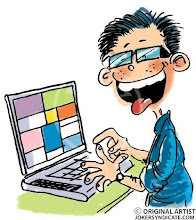How Computers Work
Input: Information and programs are entered into the computer through Input devices such as the keyboard, disks, or through other computers via network connections or modems connected to the Internet. The input device also retrieves information off disks.
Output: Output Devices displays information on the screen (monitor) or the printer and sends information to other computers. They also display messages about what errors may have occurred and brings up message or dialog box asking for more information to be input. The output device also saves information on the disk for future use.
Processing: The CPU or central processing unit is sometimes called the Control Unit and directs the operation of the input and output devices. The Coprocessoror the Arithmetic-Logic Unit does arithmetic and comparisons. The memory orRAM temporarily stores information (files and programs) while you are using or working on them. The BIOS or basic input/output system controls the dialogue between the various devices.
Keyboard Layout and Data Entry
ENTER or RETURN - Moves the cursor down one line and to the left margin. Enter also process commands such as choosing an option in a dialog (message) boxes and submitting a form.
DEL or DELETE - Deletes the character at cursor and/or characters to the right of the cursor and all highlighted (or selected) text.
BKSP or BACKSPACE - Deletes the character to the left of cursor and all hightlighted text.
SPACE BAR - Moves the cursor one space at a time to the right
SHIFT KEY - Use the shift keys to type capital letters and to type the upper character on keys with two characters on them
CAPS LOCK - Locks the keyboard so it types capital letters (a light goes on when caps lock is on)
TAB - Moves the cursor five spaces to the right (number of spaces are usually adjustable). Tab moves to the next field in a form or table (Shift-Tab for previous field).
ESC or ESCAPE - Cancels a menu or dialog box
ARROW KEYS - Moves the cursor around document without changing text
FUNCTION KEYS or F KEYS - Access commands by themselves or in combination with the three command keys; CTRL, SHIFT, and ALT
Command or Special Keys
Command keys normally do nothing on their own but work in combination with other keys. Each piece of software uses the command keys differently though there is a move to standardize some functions. The Control key or Ctrl is often used to access commands. The Alternative key or Alt is often used to access menus. The Shift key is used to type CAPITAL LETTERS. As well the command keys are all used to move through documents and edit text faster and easier. As well many computers have Special keys design specifically for the particular computer. Apple computers have the Apple keys and Macs have Command keys. Many keyboards now have a Windows key specifically for Windows 9x and newer systems. Many older computers also have special keys used for a variety of different functions.
Some Notebook or Laptop keys are left out because of space limitations and they usually have a Special function key which allows other keys to double for the missing ones.
Basic Typing Rules
Place one space between each word, after a punctuation mark and at the end of a sentence. Always start a sentence with a capital letter. Use capitals for names, addresses, provinces and countries, places, organizations, businesses, associations, schools, colleges, universities, days of the week, months, holidays, nationalities, ethnic groups and languages.
Learning the keyboard is the first step to learning computers. Learning involvespractice. It really is as simple as that. There are two kinds of typing.
The first is called Touch Typing. The Touch Typist uses the Home Keys (asdf for the left hand and jkl; for the right) and all the fingers on both hands as well as the thumbs for the Space Bar while typing. There are many commercial and public domain programs that are designed to teach this method.
The other method is some times called 'Hunt and Peck' or depending on finger strength 'Search and Destroy'. This involves using one or more fingers on one or two hands to type. It is a perfectly acceptable way of using a computer and many people get along fine with this technique.



































0 comments:
Post a Comment